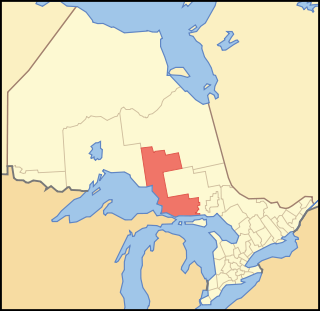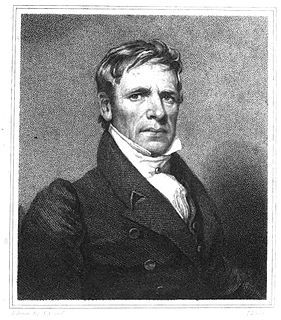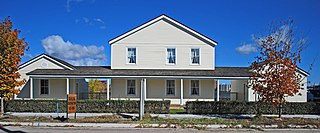
Mackinac Island is an island and resort area, covering 4.35 square miles (11.3 km2) in land area, in the U.S. state of Michigan. The name of the island in Odawa is Michilimackinac and "Mitchimakinak" in Ojibwemowin meaning "Big Turtle". It is located in Lake Huron, at the eastern end of the Straits of Mackinac, between the state's Upper and Lower Peninsulas. The island was long home to an Odawa settlement and previous indigenous cultures before European colonization began in the 17th century. It was a strategic center of the fur trade around the Great Lakes. Based on a former trading post, Fort Mackinac was constructed on the island by the British during the American Revolutionary War. It was the site of two battles during the War of 1812 before the northern border was settled and the US gained this island in its territory.

Sault Ste. Marie is the only city in, and county seat of, Chippewa County in the U.S. state of Michigan. With a population of 13,337 at the 2020 census, it is the second-most populated city in the Upper Peninsula after Marquette. It is the central city of the Sault Ste. Marie, MI Micropolitan Statistical Area, which encompasses all of Chippewa County and had a population of 38,520 at the 2010 census.

St. Ignace is a city in the U.S. state of Michigan and the county seat of Mackinac County. The city had a population of 2,452 at the 2010 census. St. Ignace Township is located just to the north of the city, but the two are administered autonomously.

Algoma District is a district and census division in Northeastern Ontario in the Canadian province of Ontario.

Henry Rowe Schoolcraft was an American geographer, geologist, and ethnologist, noted for his early studies of Native American cultures, as well as for his 1832 expedition to the source of the Mississippi River. He is also noted for his major six-volume study of Native Americans commissioned by Congress and published in the 1850s.

Fort Mackinac is a former British and American military outpost garrisoned from the late 18th century to the late 19th century in the city of Mackinac Island, Michigan, on Mackinac Island. The British built the fort during the American Revolutionary War to control the strategic Straits of Mackinac between Lake Michigan and Lake Huron, and by extension the fur trade on the Great Lakes. The British did not relinquish the fort until thirteen years after the end of the American Revolutionary War. Fort Mackinac later became the scene of two strategic battles for control of the Great Lakes during the War of 1812. During most of the 19th century, it served as an outpost of the United States Army. Closed in 1895, the fort has been adapted as a museum on the grounds of Mackinac Island State Park.

The Leelanau Peninsula is a peninsula of the U.S. state of Michigan that extends about 30 miles (50 km) from the western side of the Lower Peninsula of Michigan into Lake Michigan. Leelanau County encompasses the entire peninsula. It is often referred to as the "little finger" of the mitten-shaped lower peninsula.

The Sault Ste. Marie Tribe of Chippewa Indians, commonly shortened to Sault Tribe of Chippewa Indians or the more colloquial Soo Tribe, is a federally recognized Native American tribe in what is now known as Michigan's Upper Peninsula. The tribal headquarters is located within Sault Ste. Marie, the major city in the region, which is located on the St. Marys River.

John Tanner, known also by his Ojibwe name Shaw-shaw-wa-ne-ba-se, was captured by Ojibwe Indians as a child after his family had homesteaded on the Ohio River in present-day Kentucky. He grew up with the Ojibwe nation, becoming fully acculturated and learning the Saulteaux language. He married an Indian woman, served as a guide for European fur traders, and worked as an interpreter. His story of life with the American Indians was published in 1830. Titled A Narrative of the Captivity and Adventures of John Tanner, it was a popular success and remains an important historical record.

Fort St. Joseph is a former British outpost on the southernmost point of St. Joseph Island in Ontario, Canada, on Lake Huron. The fort consisted of a blockhouse, powder magazine, bakery building, Indian council house and storehouse surrounded by a palisade.

Magdelaine La Framboise (1780–1846), born Marguerite-Magdelaine Marcot, was one of the most successful fur traders in the Northwest Territory of the United States, in the area of present-day western Michigan. Of mixed Odawa and French descent, she was fluent in the Odawa, French, English and Ojibwe languages of the region, and partnered with her husband. After he was murdered in 1806, she successfully managed her fur trade business for more than a decade, even against the competition of John Jacob Astor. After retiring from the trade, she built a fine home on Mackinac Island.
The term mixed-blood in the United States and Canada has historically described people of multiracial backgrounds, in particular mixed European and Native American ancestry. Today, the term is often seen as pejorative.
Ozhaguscodaywayquay, also called Neengay or Susan Johnston, was an important figure in the Great Lakes fur trade before the War of 1812. She married the British fur trader John Johnston, a "wintering partner" of the North West Company. They had prominent roles in the crossroads society of Sault Ste. Marie, Michigan and the territory before 1830, and entertained notable visitors from a variety of disciplines. Their daughter Jane Johnston Schoolcraft has become recognized as the first Native American literary writer in the United States.

Jane Johnston Schoolcraft, also known as Bamewawagezhikaquay is the one of earliest Native American literary writers. She was of Ojibwa and Scots-Irish ancestry. Her Ojibwa name can also be written as O-bah-bahm-wawa-ge-zhe-go-qua, meaning "Woman of the Sound [that the stars make] Rushing Through the Sky." From babaam- 'place to place' or bimi- 'along', wewe- 'makes a repeated sound', giizhig 'sky', and ikwe 'woman'. She lived most of her life in Sault Ste. Marie, Michigan.
John Johnston (1762–1828) was a wealthy and successful British fur trader for the North West Company at Sault Ste. Marie when it was still Canadian territory before the War of 1812. He was a prominent citizen and leader in the Michigan Territory of the United States, although he never became a US citizen. He married Ozhaguscodaywayquay, daughter of Waubojeeg, a prominent Ojibwe war chief and civil leader from what is now northern Wisconsin. The Johnstons were leaders in both the Euro-American and Ojibwa communities. Johnston's life was markedly disrupted by the War of 1812, as afterward the U.S. prohibited trading by Canadians in its territory.
John A. Drew was a prominent American trader in the Mackinac area in the early 19th century; it is now considered within the boundaries of Michigan. He also was a politician, serving in the Michigan House of Representatives for the 1841 session.

Elmwood, also known as the Henry Rowe Schoolcraft House, the Schoolcraft House or the Indian Agency, is a frame house located at 435 East Water Street in Sault Ste. Marie, Michigan. It was designated a Michigan State Historic Site in 1956 and listed on the National Register of Historic Places in 1974.

The Mackinac Bands of Chippewa and Ottawa Indians is a state recognized tribe of Ojibwe and Odawa Native Americans, based in the state Michigan. The tribe is headquartered in St. Ignace, Mackinac County and has around 4,000 enrolled members. Today most tribal members live in Mackinac, Chippewa, Emmet, Cheboygan, and Presque Isle counties, however many tribal members are also located throughout the state of Michigan and the United States.

The Literary Voyager, also known as The Muzzeniegun was a manuscript magazine produced by Henry Rowe Schoolcraft between December 1826 and April 1827, for a total of 16 issues. It is recognized as the first magazine published in Michigan, as well as the first periodical pertaining to Native American culture and mythology. The magazine contained mainly Ojibwe legends and history, as well as poems and stories written by Schoolcraft’s wife, Jane Johnston Schoolcraft, an Ojibwe woman who is now recognized as the first Native American literary writer.
Henry A. Levake was an American fur trader and politician. He served in the first four sessions of the Michigan House of Representatives.



















